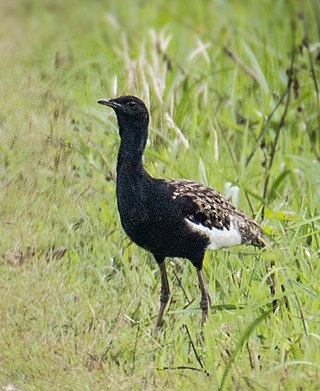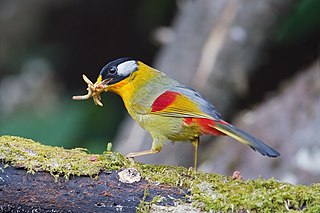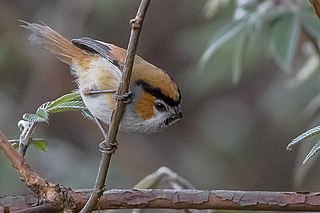
The Siberian stonechat or Asian stonechat is a recently validated species of the Old World flycatcher family (Muscicapidae). Like the other thrush-like flycatchers, it was often placed in the Turdidae in the past. It breeds in the East Palearctic including in easternmost Europe and winters in the Old World tropics.

Hume's leaf warbler or Hume's warbler is a small leaf warbler which breeds in the mountains of inner Asia. This warbler is migratory and winters mainly in India.

The crested goshawk is a bird of prey from tropical Asia. It is related to other diurnal raptors such as eagles, buzzards and harriers, and thus placed in the family Accipitridae.

The blossom-headed parakeet is a parrot in the family Psittaculidae.

Mahananda Wildlife Sanctuary is located on the foothills of the Himalayas, between the Teesta and Mahananda rivers. Situated in the Darjeeling district of West Bengal, India; it comes under Darjeeling Wildlife division and can be reached from Siliguri in 30 minutes. Sukna, the gateway to the sanctuary, is only 13 km from Siliguri and 28 km from Bagdogra airport. The sanctuary sprawls over 159 km2 of reserve forest and was started as a game sanctuary in 1955. In 1959, it got the status of a sanctuary mainly to protect the Indian bison and royal Bengal tiger, which were facing the threat of extinction.

The Eastern Himalayan broadleaf forests is a temperate broadleaf forest ecoregion found in the middle elevations of the eastern Himalayas, including parts of Nepal, India, Bhutan, Myanmar and China. These forests have an outstanding richness of wildlife.

The Bengal florican, also called the Bengal bustard, is a bustard species native to the Indian subcontinent, Cambodia, and Vietnam. It is listed as Critically Endangered on the IUCN Red List because fewer than 1,000 individuals were estimated to be alive as of 2017. It is the only member of the genus Houbaropsis.

The golden-throated barbet is an Asian barbet native to Southeast Asia, where it inhabits foremost forests between 900 and 2,700 m altitude. It is listed as Least Concern on the IUCN Red List because of its wide distribution and stable population.

The Indian grassbird is a passerine bird in the family Pellorneidae. It was formerly placed in the Old World warbler family, Sylviidae, and the Old World babbler family, Timaliidae.

The hoary-throated barwing is a species of bird in the family Leiothrichidae.

The Nepal fulvetta or Nepal alcippe, as the fulvettas proper are not closely related to this species, is a bird species in the family Alcippeidae.

The cutias are the passerine bird genus Cutia in the family Leiothrichidae. These birds are found in montane forests of continental South and Southeast Asia. The name is derived from the Nepali name khatya or khutya for the type species, the Himalayan cutia. The cutias are related to the alcippes and the laughingthrushes.

The silver-eared mesia is a species of bird from South East Asia.

The black-throated parrotbill is a parrotbill species often placed with the Old World babblers or in a distinct family Sylviidae, but it actually seems to belong to the distinct family Paradoxornithidae.

The rufous-vented tit is an Asian songbird species in the tit and chickadee family (Paridae). Some of its subspecies were formerly assigned to its western relative the rufous-naped tit, or these two were considered entirely conspecific.

The Naga wren-babbler or long-tailed wren-babbler is a bird species in the family Timaliidae. In India it is found in Nagaland and Manipur.

The spiny babbler is a species of bird in the family Leiothrichidae. Found only in the Middle Hills of Nepal, it can for example be seen around the Kathmandu valley, specifically around the Godavari and Phulchoki area close to the city of Lalitpur.

Hodgson's treecreeper is a small passerine bird from the southern rim of the Himalayas. Its specific distinctness from the common treecreeper was recently validated.

The Manipur fulvetta or streak-throated fulvetta is a bird species in the family Paradoxornithidae. It is named for the state of Manipur in Northeast India. Like the other typical fulvettas, it was long included in the Timaliidae genus Alcippe or in the Sylviidae. In addition, it was long included in F. cinereiceps as a subspecies, and the common name "streak-throated fulvetta" was applied to all these birds. The typical F. cinereiceps are now called grey-hooded fulvetta.
The Vietnamese cutia is a bird species in the family Leiothrichidae. It is found in Laos and Vietnam.
























